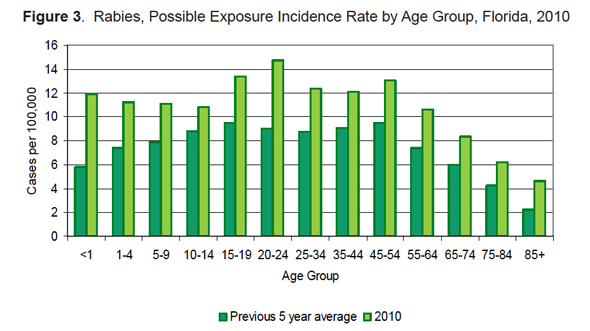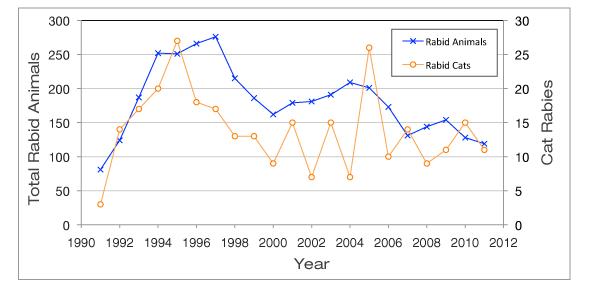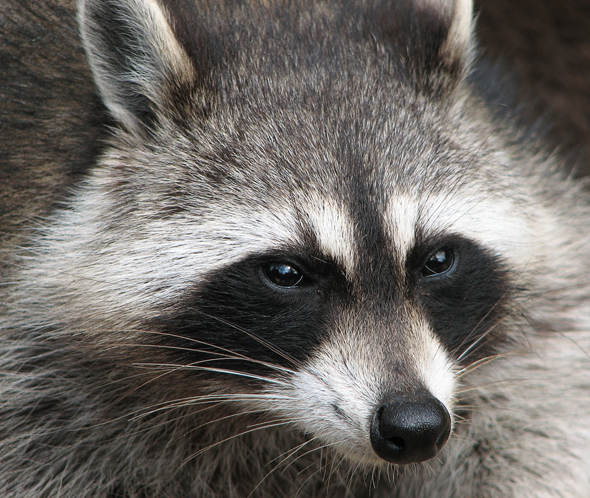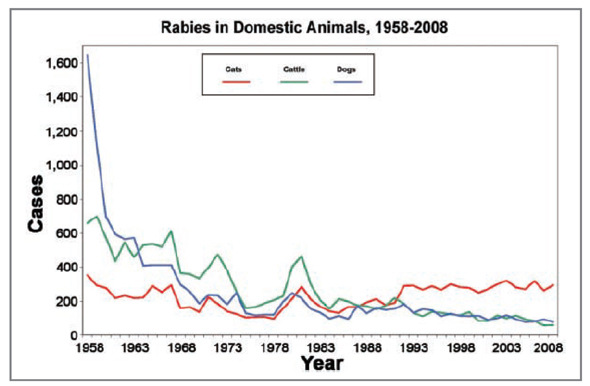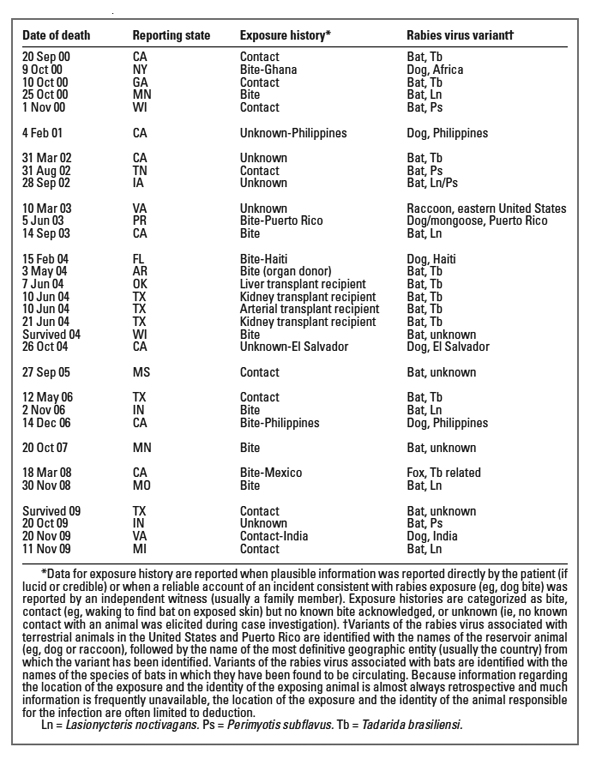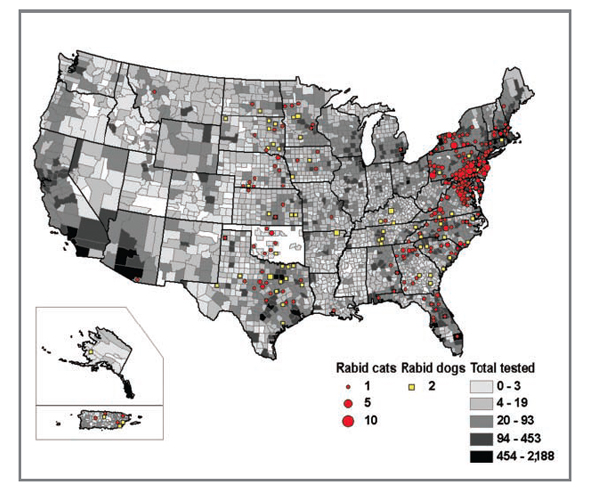Smithsonian magazine is, according to its website, “created for modern, well-rounded individuals with diverse interests” and “chronicles the arts, history, sciences and popular culture of the times.” Jess Righthand’s recent article, “The World’s Worst Invasive Mammals,” seems—despite its inclusion in the online edition’s “Science & Nature” section—better suited for the pop culture category.
Indeed, the story has more to do with sensationalism than science.
Feral Cat Population
Righthand’s claim that “there are an estimated 60 million feral cats in the United States alone” is conservative compared to some other estimates. David Jessup, for example, suggested in 2004 that there were 60–100 million [1], while, more recently, The American Bird Conservancy Guide to Bird Conservation puts the figure at 60–120 million [2] (neither cites a source).
Still, Merritt Clifton of Animal People, an independent newspaper dedicated to animal protection issues, makes a compelling argument that the population of feral cats in the U.S. is much smaller than is often reported, and may very well be on the decline. [3]
Clifton’s estimates are derived not from surveys of homeowners feeding stray and feral cats, but from “information about the typical numbers of cats found in common habitat types, gleaned from a national survey of cat rescuers… cross-compared with animal shelter intake data.” [4] In 2003, Clifton suggested that “the winter feral cat population may now be as low as 13 million and the summer peak is probably no more than 24 million.” [4]
Predation on Birds
Righthand puts the figure for annual bird deaths attributed to feral cats at “around 480 million.” Nowhere near the “one billion birds” proposed by Nico Dauphine and Robert Cooper, [5] of course, but more than enough to get the attention of Smithsonian readers.
But, as I’ve pointed out repeatedly, even high rates of predation do not equate to population declines (though, clearly, it’s easy to suggest as much). Many researchers have disputed the kind of broad, overreaching claims to which Righthand alludes. Biologist C.J. Mead, for example, reviewing the deaths of “ringed” (banded) birds reported by the British public, suggests that cats may be responsible for 6.2–31.3 percent of bird deaths. “Overall,” writes Mead, “it is clear that cat predation is a significant cause of death for most of the species examined.” Nevertheless, Mead concludes:
“there is no clear evidence of cats threatening to harm the overall population level of any particular species… Indeed, cats have been kept as pets for many years and hundreds of generations of birds breeding in suburban and rural areas have had to contend with their predatory intentions.” [6]
Mike Fitzgerald and Dennis Turner come to essentially the same conclusion: “We consider that we do not have enough information yet to attempt to estimate on average how many birds a cat kills each year. And there are few, if any studies apart from island ones that actually demonstrate that cats have reduced bird populations.” [7]
Then, too, there’s the critical distinction between compensatory and additive predation—again, a point I’ve made numerous times. Two very interesting studies have generated compelling evidence that birds killed by cats are, on average, significantly less healthy than those killed through non-predatory events (e.g., collisions with buildings). [8, 9] In other words, these birds probably weren’t going to live long enough to contribute to the overall population numbers; predation was compensatory rather than additive.
Public Health Threats
“When house cats are allowed free range outdoors by their owners,” argues Righthand, “or simply don’t have owners, they not only wreak havoc as opportunistic hunters, they can also spread disease. In addition to carrying rabies, 62 to 82 percent of cats in a recent study tested positive for toxoplasmosis.” Here, Righthand seems to be cribbing off of Hildreth, Vantassel, and Hygnstrom, of “Feral Cats and Their Management” fame—hardly a reputable source.
Rabies
Regarding rabies—a topic I’ll save for future posts—I think it’s important to put this into perspective. I happen to have data from Florida handy, and according to that state’s Department of Health, approximately 22,000 Florida residents have died of the flu or pneumonia since 2006 (actually, that figure accounts for only 24 of Florida’s 67 counties, so the total is surely much higher).
By way of comparison: from 2005 through mid-May of this year, there were 11 reported cases of rabies in humans across the entire country (though, I believe there were a handful of reported cases this summer as well).
In terms of public health, then, I think we’re all better off focusing on frequent hand washing, sneezing into our sleeves, and the like—as opposed to, say, exterminating this country’s most popular companion animal by the millions.
Toxoplasma gondii (I)
While it’s true that cats are the definitive host of Toxoplasma gondii, it’s important to note that “wild game can be a source of T. gondii infection in humans, cats, and other carnivores. Serologic data show that a significant number of feral pigs, bears, and cervids are exposed to T. gondii. [10]
“Humans,” write Elmore et al., “usually become infected through ingestion of oocyst-contaminated soil and water, tissue cysts in undercooked meat, or congenitally. Because of their fastidious nature, the passing of non-infective oocysts, and the short duration of oocyst shedding, direct contact with cats is not thought to be a primary risk for human infection.” [11]
But to Righthand’s point: the rate of cats testing positive—or seroprevalence—is, in any event, not a useful measure of their ability to infect other animals or people.
According to Dubey and Jones, “most cats seroconvert after they have shed oocysts. Thus, it is a reasonable assumption that most seropositive cats have already shed oocysts.” [12] “Testing positive,” in this case, is nothing more than the detection of antibodies resulting from seroconversion (the same process, by the way, that takes place in humans after receiving a flu shot).
So, what exactly is Righthand’s point? Did she simply not do her homework here, or is the idea to portray these cats as a threat far, far beyond what the scientific evidence supports? Both, I suspect.
Toxoplasma gondii (II)
T. gondii, Righthand continues, “has been shown to cause neurological damage to sea otters and other marine mammals that are exposed when heavy rainfall washes infected cat feces into the water.” Again, this is terrain I’ve covered previously. (Righthand, it seems, could do herself—and Smithsonian readers—a favor by subscribing to Vox Felina!)
Yes, T. gondii has been linked to the illness and death of marine life, primarily sea otters [13], prompting investigation into the possible role of free-roaming (both owned and feral) cats. [14, 15] It’s generally thought that oocysts (the mature, infective form of the parasite) are transferred from soil contaminated with infected feces to coastal waterways by way of freshwater run-off. [15]
However, one study found that 36 of 50 sea otters from coastal California were infected with the Type X strain of T. gondii [16], a type linked to wild felids (mountain lions and a bobcat, in this case), but not to domestic cats. [15] A recently published study from Germany seems to corroborate these findings. Herrmann et al. analyzed 18,259 fecal samples (all from pet cats) for T. gondii and found no Type X strain. (It’s interesting to note, too, that only 0.25% of the samples tested positive for T. gondii). [17]
Once again, we’re back to the question: What is Righthand trying to accomplish here?
Population Impacts
“Cats have,” writes Righthand, “also hurt populations of birds, reptiles and other creatures. The black stilt of New Zealand (a seabird), the Okinawa woodpecker and the Cayman Island ground iguana are just a few of the dozens of endangered species at risk due to the proliferation of feral cats.”
At the risk of pointing out the obvious, endangered species are—by definition—at risk due to the proliferation of all sorts of threats. That’s how they became endangered in the first place. To suggest, as Righthand does, that cats are the sole threat these animals face is both misleading and irresponsible.
Righthand (taking a cue, perhaps, from the authors of The ABC Guide?) also makes the common mistake of using island impacts (which are, themselves, more complex than often acknowledged) to imply impacts elsewhere (better yet: everywhere). Readers, it seems, are on their own in terms of doing any research on the topic.
Mission Failure
How much of the blame we can put on Righthand, I don’t know. According to Smithsonian’s website, she’s an intern with the magazine. Had the editors wanted a more thoroughly researched article, they could have demanded one. (This, some readers will recall, is not the first time I’ve been disappointed with the Smithsonian’s lack of rigor.)
According to its website, the mission of the Smithsonian is straightforward but ambitious: “the increase and diffusion of knowledge.” Righthand’s article—misleading at best—falls well short. It seems she’s still struggling with how to best express the organization’s proclaimed values—in this case, going overboard on the creativity at the expense of excellence and integrity.
Literature Cited
1. Jessup, D.A., “The welfare of feral cats and wildlife.” Journal of the American Veterinary Medical Association. 2004. 225(9): p. 1377-1383. http://avmajournals.avma.org/doi/abs/10.2460/javma.2004.225.1377
2. Lebbin, D.J., Parr, M.J., and Fenwick, G.H., The American Bird Conservancy Guide to Bird Conservation. 2010, London: University of Chicago Press.
3. Clifton, M. (2003) Roadkills of cats fall 90% in 10 years—are feral cats on their way out? http://www.animalpeoplenews.org/03/11/roadkills1103.html Accessed May 23, 2010.
4. Clifton, M. Where cats belong—and where they don’t. Animal People 2003 [cited 2009 December 24]. http://www.animalpeoplenews.org/03/6/wherecatsBelong6.03.html.
5. Dauphiné, N. and Cooper, R.J., Impacts of Free-ranging Domestic Cats (Felis catus) on birds in the United States: A review of recent research with conservation and management recommendations, in Fourth International Partners in Flight Conference: Tundra to Tropics. 2009. p. 205–219. www.pwrc.usgs.gov/pif/pubs/McAllenProc/articles/PIF09_Anthropogenic%20Impacts/Dauphine_1_PIF09.pdf
6. Mead, C.J., “Ringed birds killed by cats.” Mammal Review. 1982. 12(4): p. 183-186. http://dx.doi.org/10.1111/j.1365-2907.1982.tb00014.x
7. Fitzgerald, B.M. and Turner, D.C., Hunting Behaviour of domestic cats and their impact on prey populations, in The Domestic Cat: The biology of its behaviour, D.C. Turner and P.P.G. Bateson, Editors. 2000, Cambridge University Press: Cambridge, U.K.; New York. p. 151–175.
8. Baker, P.J., et al., “Cats about town: is predation by free-ranging pet cats Felis catus likely to affect urban bird populations?“ Ibis. 2008. 150: p. 86-99. http://dx.doi.org/10.1111/j.1474-919X.2008.00836.x
9. Møller, A.P. and Erritzøe, J., “Predation against birds with low immunocompetence.” Oecologia. 2000. 122(4): p. 500-504. http://www.springerlink.com/content/ghnny9mcv016ljd8/
10. Hill, D.E., Chirukandoth, S., and Dubey, J.P., “Biology and epidemiology of Toxoplasma gondii in man and animals.” Animal Health Research Reviews. 2005. 6(01): p. 41-61. http://journals.cambridge.org/action/displayAbstract?fromPage=online&aid=775956&fulltextType=RA&fileId=S1466252305000034
11. Elmore, S.A., et al., “Toxoplasma gondii: epidemiology, feline clinical aspects, and prevention.” Trends in Parasitology. 26(4): p. 190-196. http://www.sciencedirect.com/science/article/B6W7G-4YHFWNM-1/2/2a468a936eb06649fde0463deae4e92f
12. Dubey, J.P. and Jones, J.L., “Toxoplasma gondii infection in humans and animals in the United States.” International Journal for Parasitology. 2008. 38(11): p. 1257-1278. http://www.sciencedirect.com/science/article/B6T7F-4S85DPK-1/2/2a1f9e590e7c7ec35d1072e06b2fa99d
13. Jones, J.L. and Dubey, J.P., “Waterborne toxoplasmosis – Recent developments.” Experimental Parasitology. 124(1): p. 10-25. http://www.sciencedirect.com/science/article/B6WFH-4VXB8YT-2/2/8f9562f64497fe1a30513ba3f000c8dc
14. Dabritz, H.A., et al., “Outdoor fecal deposition by free-roaming cats and attitudes of cat owners and nonowners toward stray pets, wildlife, and water pollution.” Journal of the American Veterinary Medical Association. 2006. 229(1): p. 74-81. http://avmajournals.avma.org/doi/abs/10.2460/javma.229.1.74
15. Miller, M.A., et al., “Type X Toxoplasma gondii in a wild mussel and terrestrial carnivores from coastal California: New linkages between terrestrial mammals, runoff and toxoplasmosis of sea otters.” International Journal for Parasitology. 2008. 38(11): p. 1319-1328. http://www.sciencedirect.com/science/article/B6T7F-4RXJYTT-2/2/32d387fa3048882d7bd91083e7566117
16. Conrad, P.A., et al., “Transmission of Toxoplasma: Clues from the study of sea otters as sentinels of Toxoplasma gondii flow into the marine environment.” International Journal for Parasitology. 2005. 35(11-12): p. 1155-1168. http://www.sciencedirect.com/science/article/B6T7F-4GWC8KV-2/2/2845abdbb0fd82c37b952f18ce9d0a5f
17. Herrmann, D.C., et al., “Atypical Toxoplasma gondii genotypes identified in oocysts shed by cats in Germany.” International Journal for Parasitology. 2010. 40(3): p. 285–292. http://www.sciencedirect.com/science/article/B6T7F-4X1J771-2/2/dc32f5bba34a6cce28041d144acf1e7c

